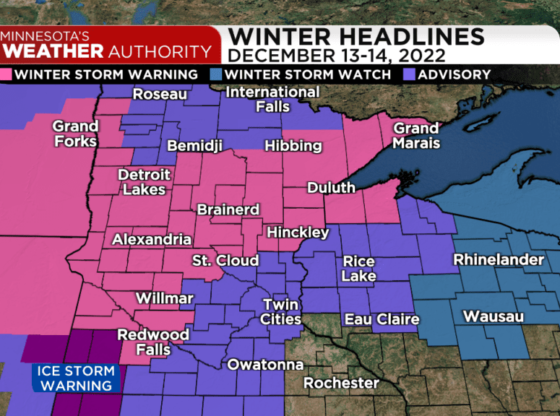A Winter Weather Advisory has been issued for northern Minnesota and northwest Wisconsin, signaling the onset of significant winter weather conditions. This advisory is crucial for residents and travelers in the affected areas to prepare for potential hazards such as snow, ice, and freezing temperatures.
Expected Weather Conditions
Snowfall
- Accumulation: The advisory forecasts moderate snowfall across northern Minnesota and northwest Wisconsin, with accumulations ranging from 3 to 6 inches in most areas. Higher elevations and localized regions may see even greater totals.
- Timing: Snowfall is expected to begin in the early morning hours and continue throughout the day, tapering off by late evening.
Ice
- Freezing Rain: Periods of freezing rain may occur, leading to the formation of ice on roads, sidewalks, and other surfaces. Ice accumulations could range from a light glaze to a quarter of an inch in some areas.
- Hazards: Ice can create hazardous travel conditions, increasing the risk of accidents and injuries.
Wind and Visibility
- Wind: Winds are expected to range from 10 to 20 mph, with gusts up to 30 mph. These winds can cause blowing and drifting snow, further reducing visibility.
- Visibility: Reduced visibility due to blowing snow and potential whiteout conditions can make travel extremely dangerous.
Also Read: Jim Caviezel Net Wealth: Hollywood to Finance
Safety Precautions
Travel Safety
- Avoid Non-Essential Travel: If possible, avoid travel during the advisory period. If you must travel, allow extra time and drive with caution.
- Prepare Your Vehicle: Ensure your vehicle is equipped with winter essentials such as an ice scraper, blankets, food, water, and a first-aid kit.
- Check Road Conditions: Monitor local news and weather channels for updates on road conditions and closures.
Home Safety
- Stock Supplies: Keep an emergency supply of food, water, medications, and other essentials in case you are unable to leave your home for an extended period.
- Heat and Insulation: Ensure your home is well-insulated and your heating system is functioning properly. Have a backup heat source in case of power outages.
- Prevent Freezing Pipes: Let faucets drip and open cabinet doors to allow warm air to circulate around plumbing.
Outdoor Safety
- Dress Appropriately: Wear layers of warm clothing, including hats, gloves, and scarves. Frostbite and hypothermia can occur quickly in freezing temperatures.
- Stay Informed: Keep a battery-powered weather radio or other means of receiving weather updates.
Conclusion
The Winter Weather Advisory for northern Minnesota and northwest Wisconsin serves as a crucial reminder to prepare for potentially severe winter weather conditions. By understanding the expected weather, taking necessary precautions, and staying informed, residents can minimize risks and stay safe during this period. Whether at home or on the road, preparedness is key to navigating winter weather safely.
Also Read: Chinese Greeting “你好” (Nǐ hǎo) Meaning and Usage
FAQs
Q1: What is a Winter Weather Advisory?
A1: A Winter Weather Advisory is issued by the National Weather Service to alert the public to potentially hazardous winter weather conditions, including snow, ice, and cold temperatures, that may impact travel and daily activities.
Q2: How long will the Winter Weather Advisory last?
A2: The duration of the advisory can vary, but it typically lasts for 12 to 24 hours, depending on the forecasted weather conditions. Specific start and end times will be provided in the advisory.
Q3: What should I do if I have to travel during the advisory?
A3: If travel is necessary, ensure your vehicle is winter-ready, drive slowly and cautiously, and keep an emergency kit in your car. Check road conditions and weather updates frequently.
Q4: How can I stay updated on the latest weather conditions?
A4: Stay informed by monitoring local news stations, weather websites, and apps, or by using a weather radio. The National Weather Service website and social media accounts are also reliable sources for updates.
Q5: What are the signs of frostbite and hypothermia?
A5: Frostbite symptoms include numbness, tingling, or a stinging sensation in the affected area, followed by pale, hard skin. Hypothermia symptoms include shivering, confusion, slurred speech, and drowsiness. Seek medical attention immediately if you experience these symptoms.


